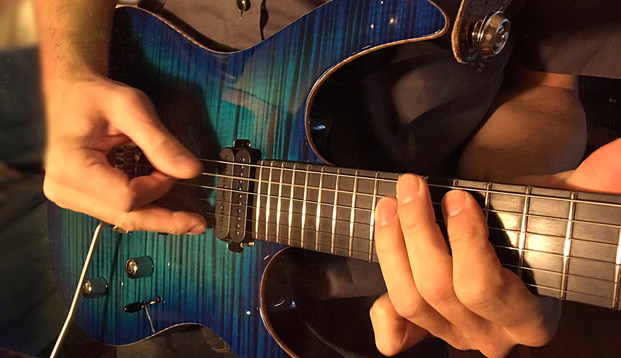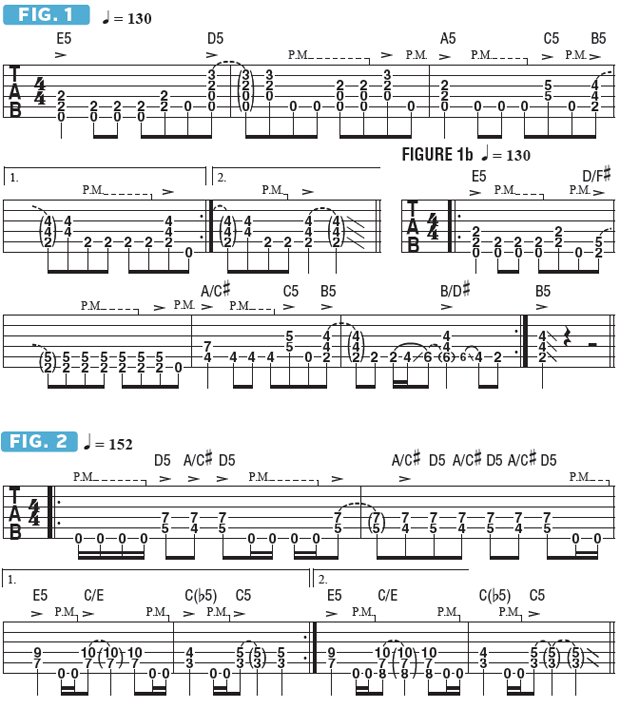How to Fortify Power-Chord Ideas with Single-Note Lines and Diads
Learn a variety of ways you can bring more melodic content to your power-chord-driven ideas through the use of single-note lines and small two-note chord voicings.

I call this month’s column “The Riff Welder” because in it I demonstrate a variety of ways you can bring more melodic content to your power-chord-driven ideas through the use of single-note lines and small two-note chord voicings, often referred to as “diads.”
I will take a few fairly “stock” chord progressions and, by moving a few notes and voicings around, show you how to devise much more interesting and effective rhythm parts.
Let’s start with a basic chord progression built from mostly open power chords, as illustrated in Figure 1A. The first three chords used in the progression—E5, D5 and A5—are all played in first or second position and include as many open strings as possible. For C5, I simply barre my index finger across the D and G strings at the fifth fret, and end the progression with a second-position B5 power chord.
Now let’s embellish this rhythm part with a few subtle tweaks to the chord voicings, as shown in Figure 1B. I begin with the same E5 power chord, but I replace the standard D5 power chord used in Figure 1A with a two-note diad played on the bottom two strings, consisting of the notes F# (sixth string, second fret) and D (fifth string, fifth fret), which produce the chord D/F# (described as “D over F#,” or “D with an F# in the bass”). In this voicing, the major third of the chord is the bottom note, and the root note is played three frets higher on the next higher string.
I then take this same“third-in-the-bass” shape and move it over to the A and D strings and up two frets to sound the next chord, A/ Cs, which takes the place of the A5 power chord used in the original example. I then use the same C5 and B5 power chords as in Figure 1A but move from B5 into B/D# by placing the major third of B, D#, on the A string’s sixth fret under an index-finger barre across the D and G strings at the fourth fret.
Now let’s take this “third-in-the-bass” idea and expand on it with a faster, slightly more intricate example. As shown in Figure 2, the rhythm part is driven by the insistent use of palm-muted 16th notes on the open low E string, punctuated by two-note chord stabs.
In bars 1 and 2 of this figure, I quickly alternate between D5 and A/C# by simply moving the note on the A string down and up one fret while keeping the same A note fretted on the D string with my pinkie. In bars 3 and 4, I switch the idea around by changing the note on the D string, raising it and lowering it one fret, while keeping a constant note on the A string. This is a simple but effective way to make a standard chord progression more interesting by creating an “internal melody.”
Our last example, Figure 3, is played at a slower tempo and works a series of two-note voicings against the open A string. I begin with an index-finger barre across the D and G strings at the fifth fret, sounding C5/A, then drop the note on the D string down one fret to produce D7/A.
In bar 3, this note is dropped an additional fret, yielding Dm7/A (this can also be thought of as F5/A). I wrap things up by dropping this note one more fret to sound Am, with the fifth of A, E, played on the D string and the minor third, C, fretted on the G string.


Get The Pick Newsletter
All the latest guitar news, interviews, lessons, reviews, deals and more, direct to your inbox!









![Joe Bonamassa [left] wears a deep blue suit and polka-dotted shirt and plays his green refin Strat; the late Irish blues legend Rory Gallagher [right] screams and inflicts some punishment on his heavily worn number one Stratocaster.](https://cdn.mos.cms.futurecdn.net/cw28h7UBcTVfTLs7p7eiLe.jpg)
